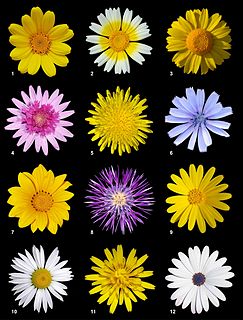
The family Asteraceae, alternatively Compositae, consists of over 32,000 known species of flowering plants in over 1,900 genera within the order Asterales. Commonly referred to as the aster, daisy, composite, or sunflower family, Compositae were first described in 1740. The number of species in Asteraceae is rivaled only by the Orchidaceae, and which is the larger family is unclear as the quantity of extant species in each family is unknown.
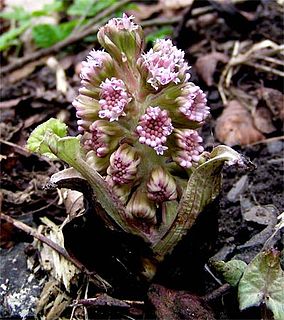
Petasites is a genus of flowering plants in the sunflower family, Asteraceae, that are commonly referred to as butterburs and coltsfoots. They are perennial plants with thick, creeping underground rhizomes and large rhubarb-like leaves during the growing season. Most species are native to Asia or southern Europe.

Tussilago farfara, commonly known as coltsfoot, is a plant in the groundsel tribe in the daisy family Asteraceae, native to Europe and parts of western and central Asia. The name "tussilago" is derived from the Latin tussis, meaning cough, and ago, meaning to cast or to act on. It has had uses in traditional medicine, but the discovery of toxic pyrrolizidine alkaloids in the plant has resulted in liver health concerns.

Petasites frigidus, the Arctic sweet coltsfoot or Arctic butterbur, is a species of flowering plant in the daisy family Asteraceae. It is native to Arctic to cool temperate regions of the Northern Hemisphere in northern Europe, northern Asia and northern North America.
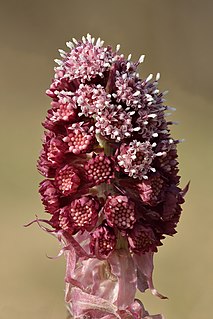
Petasites hybridus, the butterbur, is a herbaceous perennial flowering plant in the daisy family Asteraceae, native to Europe and northern Asia.

Leucanthemum is a genus of flowering plants in the aster family, Asteraceae. It is mainly distributed in southern and central Europe. Some species are known on other continents as introduced species, and some are cultivated as ornamental plants. The name Leucanthemum derives from the Greek words λευκός – leukos ("white") and ἄνθεμον – anthemon ("flower"). Common names for Leucanthemum species usually include the name daisy, but "daisy" can also refer to numerous other genera in the Asteraceae family.
Flax is a plant cultivated for food and fiber in cooler regions of the world.
Woundwort is the common name for several species of plants and may refer to:

Olearia, most commonly known as daisy-bush, is a genus of flowering plants belonging to the family Asteraceae, the largest of the flowering plant families in the world. Olearia are found in Australia, New Guinea and New Zealand. The genus includes herbaceous plants, shrubs and small trees. The latter are unusual among the Asteraceae and are called tree daisies in New Zealand. All bear the familiar daisy-like composite flowerheads in white, pink, mauve or purple.

Petasites japonicus, also known as butterbur, giant butterbur, great butterbur and sweet-coltsfoot, is an herbaceous perennial plant in the family Asteraceae. It is native to China, Japan, Korea and Sakhalin and introduced in Europe and North America. It was introduced to southern British Columbia by Japanese immigrants.
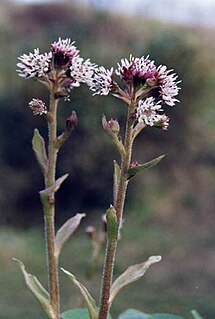
Petasites pyrenaicus, the winter heliotrope, is a medicinal and ornamental flowering plant in the daisy family Asteraceae.
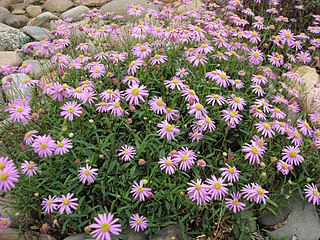
Brachyscome is a genus of flowering plants in the aster family, Asteraceae. Most are endemic to Australia, and a few occur in New Zealand and New Guinea.
Dusty Miller may refer to:
Wireweed may refer to several organisms, including:
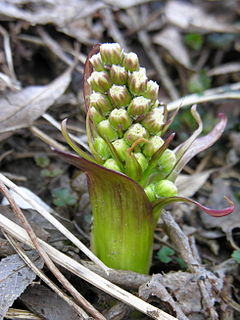
Petasites spurius is a species of flowering plant in the daisy family Asteraceae.
Coltsfoot is the common name for several plants in the family Asteraceae:
Amblyolepis is a genus of flowering plants in the daisy family described as a genus in 1836.
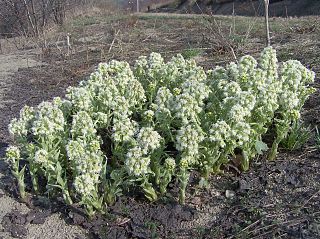
Petasites albus, the white butterbur, is a flowering plant species in the daisy family Asteraceae. It is native to central Europe and the Caucasus.
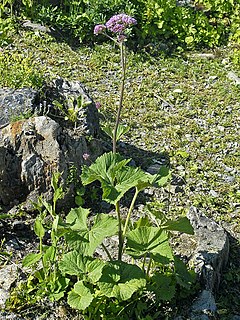
Adenostyles alliariae is herbaceous perennial flowering plant in the daisy family Asteraceae.
This page is based on this
Wikipedia article Text is available under the
CC BY-SA 4.0 license; additional terms may apply.
Images, videos and audio are available under their respective licenses.












